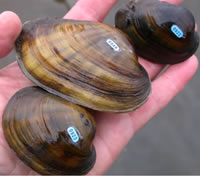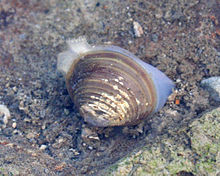
Clam is a common name for several kinds of bivalve molluscs. The word is often applied only to those that are edible and live as infauna, spending most of their lives halfway buried in the sand of the seafloor or riverbeds. Clams have two shells of equal size connected by two adductor muscles and have a powerful burrowing foot. They live in both freshwater and marine environments; in salt water they prefer to burrow down into the mud and the turbidity of the water required varies with species and location; the greatest diversity of these is in North America.

In botany, apomixis is asexual development of seed or embryo without fertilization. However, other definitions include replacement of the seed by a plantlet or replacement of the flower by bulbils.
The Dreissenidae are a family of small freshwater mussels, aquatic bivalve molluscs. They attach themselves to stones or to any other hard surface using a byssus. The shells of these bivalves are shaped somewhat like those of true mussels, and they also attach themselves to a hard substrate using a byssus; however, this group is not at all closely related to true mussels, being more closely related to the venus clams (Veneridae).

The Unionidae are a family of freshwater mussels, the largest in the order Unionida, the bivalve molluscs sometimes known as river mussels, or simply as unionids.

Corbicula fluminea is a species of freshwater clam native to eastern Asia which has become a successful invasive species throughout the world, including North America, South America, Europe, and New Zealand. It is native to freshwater environments of Eastern Asia, including Russia, Thailand, the Philippines, China, Taiwan, Korea, and Japan. C. fluminea also occurs naturally in freshwater environments of Africa. Corbicula fluminea is commonly known in the west as the Asian clam, Asiatic clam, or Asian gold clam. In Southeast Asia, C. fluminea is known as the golden clam, prosperity clam, pygmy clam, or good luck clam. In New Zealand, it is commonly referred as the freshwater gold clam.

The Corbiculidae are a family of clams in the mollusc order Venerida. They are known commonly as basket clams. The family name comes from the root corbus ("basket"), and was inspired by the concentric ribbing of the shells.

Sphaerium is a genus of very small freshwater clams, aquatic bivalve molluscs in the family Sphaeriidae, known as the fingernail clams. The small clams in this genus are unusual in that many of them, such as Sphaerium corneum, can climb around underwater on aquatic plants, using their long and strong foot.

Unionida is a monophyletic order of freshwater mussels, aquatic bivalve molluscs. The order includes most of the larger freshwater mussels, including the freshwater pearl mussels. The most common families are the Unionidae and the Margaritiferidae. All have in common a larval stage that is temporarily parasitic on fish, nacreous shells, high in organic matter, that may crack upon drying out, and siphons too short to permit the animal to live deeply buried in sediment.

Lampsilis higginsii is a rare species of freshwater mussel known as Higgins' eye pearly mussel or simply Higgins' eye. It is endemic to the United States, where it occurs in the upper Mississippi River and the drainages of some of its tributaries. It is threatened by the introduced zebra mussel. Lampsilis higginsii is a federally listed endangered species.
Freshwater bivalves are one kind of freshwater mollusc, along with freshwater snails. They are bivalves that live in fresh water as opposed to salt water, which is the main habitat type for bivalves.

Corbicula japonica is an edible species of brackishwater clam, a bivalve mollusk in the family Cyrenidae, the basket clams. Its common names include Japanese basket clam, Japanese blue clam, and shijimi.

Potomida littoralis is a species of bivalve belonging to the family Unionidae.











